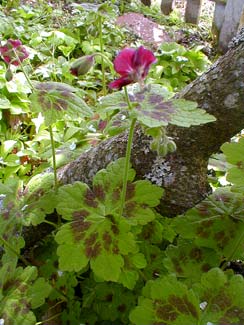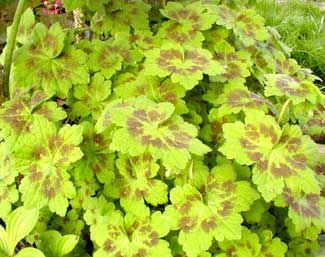
'Samobor'
Mourning-Widow Crane's-bill
"Beautiful Evelyn Hope is dead!
Sit and watch by her side an hour.
That is her book-shelf, this her bed;
She pluck'd that piece of geranium-flower,
Beginning to die too, in the glass;
Little has yet been changed, I think:
The shutters are shut, no light may pass
Save two long rays thro' the hinge's chink."
-Robert Browning
(1812-1889)
(1812-1889)
Geranium phaeum ssp phaeum 'Samobor' (about a fifth of the time misspelled 'Samobar') has two outstanding features. First is the leaves, each scallop having a cherry-black dot when the leaves emerge, aging into a large purple marking.
These markings sometimes bleed into one another, scallop to scallop, forming a nearly unbroken circle of darkness around the middle of each green leaf. The markings can be very different from plant to plant, but also can change as the leaf ages, so that sometimes it will be seen as decidedly with a circle of spots, & sometimes with a complete ring.
The second pleasing feature would be its small, reflexed, burgundy flowers, which rise above the leafy clump on upright stems. The flowers are typical of the species & give the species its common name, Mourning Widow. We have another of the type, Geranium phaeum var purpureum, the Dusky Mourning Widow.
 'Samobor' was discovered in 1990 by Elizabeth Strangman of Washfield Nursery in Kent, England, where the very first 'Samobor' in cultivation still grows. It is a natural variant found growing in damp woods in Croatia. It is named for the Croation town of Samobor.
'Samobor' was discovered in 1990 by Elizabeth Strangman of Washfield Nursery in Kent, England, where the very first 'Samobor' in cultivation still grows. It is a natural variant found growing in damp woods in Croatia. It is named for the Croation town of Samobor.As a true wildflower rather than a cultivar, it will self-seed with the seedlings growing true to the parent. If, however, there are other varieties of G. phaeum nearby, they will crosspollinate for random forms.
One of our local nurseries here in Kitsap County, Heronswood, is world-famed, & they introduced the natural variant to North American gardening. It did not take long to become a standard offering.
It wants sun to light shade & is cold-hardy down to zone 2, but intolerant of warm climates, not wanting to gardened above zone 8. It leafs out very beautifully in March & April, as shown in the second photo (2004). It blooms later in April & up to June; the first photo above was snapped in May (2003). When it finishes flower it can become a bit scruffy or floppy in summer heat. It should be sheared back shortly after it is done flowering; then, with good summer watering, it will return with leaves as perfect & perfectly compact as it had been for spring.
Ours is grown in very bright shade or dappled sunlight as a fill-in amidst dwarf rhodies. It does not hump up as high as most of our crane's-bills, but remains a very tidy highly compact ten or twelve inch tall clump, with considerable spread. The variety is capable of humping up to two feet high but ours has thus far remained shorter.